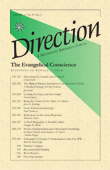Fall 2006 · Vol. 35 No. 2 · pp. 317–18
Book Review
Between Pacifism and Jihad
J. Daryl Charles. Downers Grove, IL: InterVarsity, 2005. 197 pages.
Invariably children raised in modern Mennonite homes are confronted with questions concerning which portions of their inherited faith are nonnegotiable and which portions are merely cultural baggage far removed from the central faith of Jesus and the New Testament. J. Daryl Charles, the son of a Mennonite World War II conscientious objector, has struggled with the issues raised by war and found the answers of Augustine and Niebuhr far more compelling than the answers of Grebel, Menno, and J. H. Yoder.
In the current climate, especially in the wake of September 11, 2001, Charles argues that Christians need to embrace the “consensual” view of the church on war: the just war tradition. While suggesting that this tradition represents a mediating orthodox alternative to the extremist views of holy war (jihad) and pacifism, the text reveals an author still struggling with his own Mennonite angst concerning the legitimacy of Christian involvement with war, the criminal justice system, and even the state. In spite of the title, the book does not seriously engage Christian or Islamic views of holy war or crusades to achieve Christian or Islamic ends. It is the author’s response to traditional teachings of the Mennonite Church.
For Charles, Jesus is interpreted in the light of Augustine and Augustine’s anguished defense of the church against generations of “pagan” critics who insisted that Christian political hesitancy contributed to the decline of the Roman Empire. In fact, Charles quotes approvingly Reinhold Niebuhr’s statement that modern society in the face of Hitler and later Communism cannot afford to follow the literal teachings of Jesus.
The author would have been greatly helped by exploring the full range and complexity of pacifist (or even Mennonite) thought. In fact I found his critique of the shortcomings of some forms of pacifism less convincing than John H. Yoder’s analysis in Nevertheless: The Varieties and Shortcomings of Religious Pacifism (Herald, rev. ed. 1992). His discussion of the role of war in the Old Testament and its ethical relevance for modern Christians would have been greatly enriched by exploring the nuanced thought of Mennonite Old Testament scholar Millard Lind. Further he seems completely unfamiliar with the significant Niebuhrian-engaged reflections of such Mennonite pacifists as Donovan Smucker, Guy F. Hershberger, and J. R. Burkholder.
In Charles’s mind, “the reality is that society without coercive powers is an impossibility” (127). He seems unable to appreciate that some modern states conscientiously choose to limit their own coercive power, such as Costa Rica. Further, as a native Pennsylvanian, Charles must certainly know about the impressive Quaker record of administrating a multicultural colony with greatly limited powers of coercion. In a world which has witnessed the fall of apartheid in South Africa and Communism in much of Eastern Europe to largely peaceful movements for change, it seems strange that the author sees war as the primary response to totalitarian social injustice.
Those interested in the just war tradition would be better served by reading Augustine, Niebuhr, and the contemporary work of Jean Bethke Elshtain.

